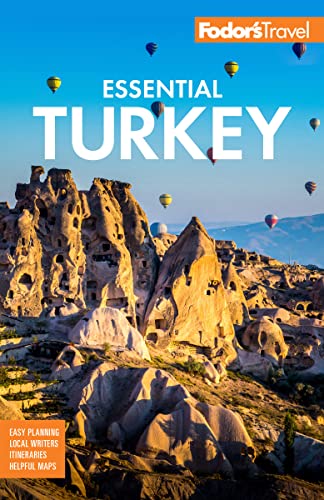Great Itinerary: Crossroads of Faith, 9 days
Once home to powerful Christian and Muslim empires, the area that makes up modern Turkey has played a crucial role in the development of both religions. This tour takes you to some of the most important religious sites in Turkey, places that still poignantly convey spirituality.
Days 1 and 2: Istanbul
Arrive in Istanbul and check into a hotel in Sultanahmet. If you have time, visit two of the quintessential Istanbul sights: the Aya Sofya and the nearby Blue Mosque.
Start your second day with a visit to the Süleymaniye Mosque, one of the greatest achievements of Mimar Sinan, the Ottomans' favorite architect. Then head to the western edge of Istanbul's old city walls, where you'll find the Kariye Museum in what was the Byzantine Chora Church. It's filled with glittering mosaics and beautiful frescoes that are considered among the finest in the world. End your day in Eyüp Camii, a historic mosque complex on the Golden Horn that is one of the holiest areas in Istanbul.
Day 3: Konya
Take a morning flight from Istanbul to Konya and pick up a rental car at the airport. In Konya you'll see the magnificent Mevlâna Museum and tomb, dedicated to the life and teachings of Rumi Celaleddin, the 13th-century mystic who founded the order of the whirling dervishes. The city's 13th-century Alaaddin Mosque is also worth a visit. In the evening, catch a live dervish performance at the cultural center behind the museum if they're performing.
Days 4 and 5: Cappadocia
After Konya, head east toward the lunar landscape of Cappadocia, where the volcanic rock outcroppings and cliffs were used by local Christians centuries ago as churches, monasteries, and homes. One of the best places to see these unique structures is in the village of Göreme. Spend the night in one of the hotels built into the stone caves. Ürgüp has what is regarded by some as the best collection of boutique hotels in Turkey.
The attractions in Cappadocia are above ground and below it. Under siege from Arab invaders in the 7th through 10th centuries, local Christians built a series of underground cities—some going down 20 stories and capable of holding 20,000 people—where they sought refuge. The ruins in Kaymaklı and Derinkuyu are marvels of ancient engineering. Get an early start if you want to beat the summer crowds, and bring a flashlight.
If you have time, consider a visit to the Ihlara Valley, a deep gorge that has numerous monasteries and churches cut into its cliffs and a lovely green river running through it.
Days 6 and 7: Cappadocia to Antakya
From landlocked Cappadocia, head south to the Mediterranean Sea and the city of Antakya, formerly known as Antioch, which played an important role in the early days of Christianity. It's a long drive of 482 km (300 miles), so plan on spending most of the day on the road. Fortunately, there's a highway for most of the way. If you get to Antakya early enough, head to the Church of St. Peter, in a cave on the outskirts of town. Blackened by 2,000 years' worth of candle smoke, this is perhaps the oldest church in the world, where the apostle Paul preached to his converts.
The next day, spend the morning walking through the narrow lanes and the lively bazaar of Antakya's old town. Then visit the Archaeological Museum, which has an excellent collection of Roman and Byzantine mosaics and other artifacts. Antakya is famous for its Syrian-influenced cooking, so have lunch at one of the restaurants serving local dishes (Antik Han or Hatay Sultan Sofrası are two good options). After lunch, begin your 351-km (218-mile) drive to Şanlıurfa, where you can stay in one of several grand old stone houses that have been converted into small hotels.
Day 8: Şanlıurfa
Many Muslims believe the biblical patriarch Abraham was born in Şanlıurfa, and a fascinating and peaceful pilgrimage site has developed here, with mosques and a park with spring-fed pools filled with sacred carp. After lunch, make the quick drive to the small village of Harran, 45 km (28 miles) southeast of Şanlıurfa. Harran is mentioned in the Bible as a place where Abraham lived for a period, and the village, with its ancient stone walls and unique beehive-shape houses, has the look of a place that hasn't changed much since biblical times. Another worthwhile side trip is the archaeological site of Göbekli Tepe, 15 km (9.3 miles) northeast of Şanlıurfa, and thought to be the world’s first temple—6,000 years before Stonehenge.
Day 9: Şanlıurfa and Return to Istanbul
You can fly back to Istanbul from Şanlıurfa, or from nearby Gaziantep (145 km [90 miles] away). If you have a flight from Şanlıurfa later in the day, take some time to explore Şanlıurfa's bustling and authentic bazaar, where coppersmiths hammer and tailors work on foot-powered sewing machines. If your flight is out of Gaziantep, consider driving there in the morning in order to have lunch at one of that city's famous restaurants. Imam Çağdaş, which has great kebabs and heavenly baklava, is your best bet.




